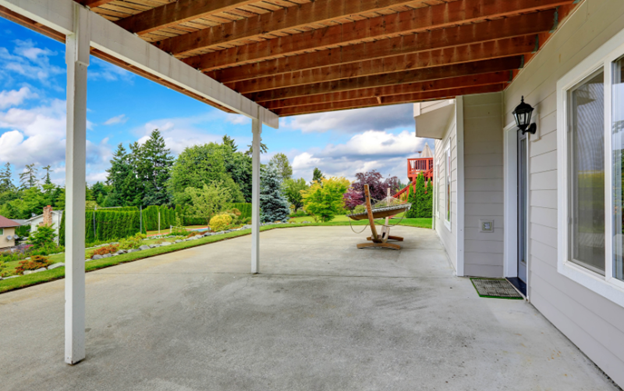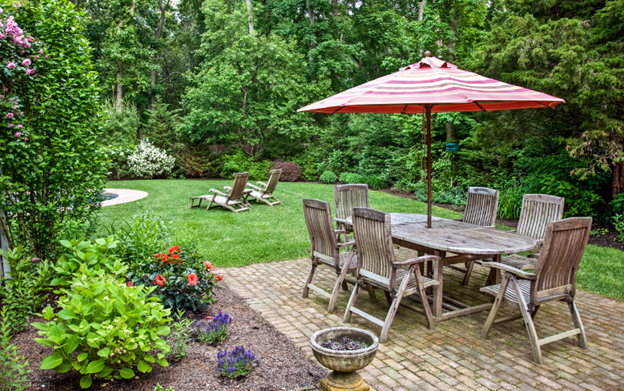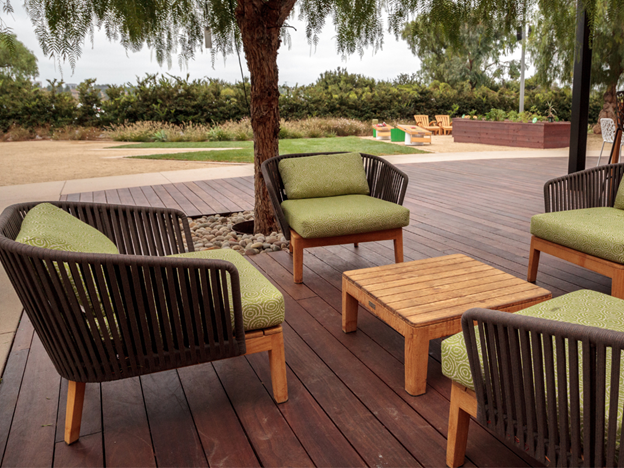A well-designed patio gives you a place to relax, entertain guests, and enjoy the outdoors without leaving the comfort of your home. This simple addition also boosts the value of your home and has an impressive return on investment. If you’re thinking about a new patio, it’s typically well worth the expense.
Beyond design, material is the most important thing to consider for your patio project. Finding the perfect patio material comes down to your budget and style preferences, the climate where you live, and durability and maintenance.
That’s why I’ve created this article on the best materials for patios. With my professional insights, you’ll find it much easier to select a surface material for your new outdoor living space.
In most cases, I find that concrete is the way to go. When you’re ready for a new concrete patio, you can find a pro to help you out below.

What Are the Best Types of Patio Materials?
When building your perfect patio, there are many materials to choose from, including:
- Concrete
- Brick
- Stone
- Pavers
- Gravel
- Wood
Each hardscape material varies in its aesthetics, durability, and maintenance requirements. You’ll also have to consider the climate where you reside and your budget. Below, I dig into all the top materials so you can decide which patio ideas work best for your home.
1. Concrete
Poured concrete isn’t just for driveways and walkways. It’s also a popular choice for patios because it looks nice, is easy to maintain, and remains highly durable in mild climates.
To get the best results, consider hiring a professional concrete installer. With their help, you can customize the look of the patio surface to enhance your home design — the possibilities are endless.
Your installer can stamp the surface to make the concrete look like natural stone without the hefty price tag. Or, they can stain it practically any color imaginable, including vivid green, purple, or orange. Burnishing or coating the surface with metallic epoxies can even mimic the look of marble.
Plain concrete patio materials cost anywhere from $8 to $15 per square foot. Artistic finishes can add up to $16 per square foot. Labor adds $5 to $15 per square foot if you hire a contractor. You might also have to pay a delivery fee.
With proper installation, concrete patios should last up to 50 years, and sealing the surface every few years can help you get the most out of your investment. However, those living in frigid climates take note: Freezing weather and extreme temperature changes can cause concrete to crack, taking years off the life of your patio.
Related: Dressing Up A Patio Floor

Don’t make the same mistake I did and let cracks in your concrete patio go too long without repairing them. Despite knowing better, I let the cracks grow past a ¼ of an inch wide, resulting in even more damage. If I had filled the small cracks, I could have saved my patio. Now, it’s time for a full rebuild.
2. Brick
Brick is the way to go if you want a charming patio design that’s durable in all climates and can be easily repaired. This material offers a wealth of design options, even though most bricks only come in a few colors, like red, gray, and blonde.
To customize your design, select your preferred brickwork pattern, such as:
- Herringbone
- Basketweave
- Running bond
- Stacked bond
- Flemish bond
- Diagonal bond
- Coursed ashlar
You can also add a personal touch by using multiple patterns separated by a vertical or horizontal brick border.
If you have the patience, building a brick patio is a reasonably DIY-friendly project, especially if you use the sand set method. This method entails arranging the bricks over a compact aggregate layer and then filling the joints with sand. You can always hire a contractor if you feel overwhelmed or are unsatisfied with the DIY results.
When building the patio yourself, expect materials to cost $8 to $30 per square foot for basic extruded bricks. Custom sand-molded or handmade bricks cost even more. Labor adds about $10 per square foot when hiring an installer.

A brick patio should last about 50 to 75 years when regularly cleaned and maintained. To extend its life, it’s best to perform occasional maintenance. Scrub the surface with an algae remover annually and apply brick sealer every two to five years. You should also pull weeds out of the joints as they appear and refill gaps with more sand. If you notice any damaged bricks, remove and replace them.
3. Stone
Nothing comes close to matching the style and sophistication of stone patios. So, if you’re looking for pure elegance, set your sights on natural stone materials like limestone, slate, or travertine.
Stone building materials come in various colors, textures, and shapes, allowing you to create a truly unique patio design. For a rustic appearance, quartzite flagstone cut into irregular shapes will do the trick. Bluestone tiles let you create a uniform pattern while adding color variations, ranging from blue and purple to orange and green.
Working with stone is difficult, so plan to hire a contractor when using this material for your patio. You’ll likely pay around $15 per square foot for labor, but it’s well worth the expense, as installing a stone patio can be challenging.
As for materials, natural stone costs between $15 and $35 per square foot, depending on your chosen stone type. Granite, bluestone, and travertine are on the upper end of the range, while flagstone is better for homeowners on a budget.

Once properly installed, your stone patio should last up to 100 years. To extend its life, sweep and scrub the stones monthly and apply stone sealer every decade or so. Keeping heavy patio furniture off the stone’s surface helps to prevent chips and cracks.
If you live in a cold climate, skip porous stones like limestone and travertine in favor of granite. Brick also withstands freezing weather well, making it an ideal option for colder climates. If you have your heart set on travertine, clean all the snow and ice off your patio as it builds up to help prevent the material from cracking.
4. Pavers
Pavers have all the beauty of brick and natural stone but without the high price tag. This patio material comes in various colors, shapes, and sizes, although interlocking concrete pavers are the most popular option.
If you want a patio design with more flair, use modular stone or brick pavers. Instead of locking together, these pavers can be arranged in any pattern imaginable. For a classic appearance, go with basic brickwork patterns, like herringbone, basketweave, or running bond. Or, shake things up with circular or European fan designs.
Much like brick, installing pavers is an approachable DIY patio project — as long as you bring your patience. Take the time to create a compact gravel foundation, and the rest will come together easily. Complex patterns are better handled by a professional unless you’re OK with potentially redoing a few sections to get it just right.

If you go the DIY route, a paver patio costs around $5 to $20 per square foot for materials alone. When hiring an expert, labor is another $10 or more per square foot, depending on the desired pattern.
Your investment should last between 20 and 30 years with the proper level of care. For the longest lifespan, remove weeds from the joints before they can displace the pavers. Otherwise, you’ll end up with an uneven surface. You should also clean the paver patio monthly and reseal the surface every three to five years to prevent staining.
Most popular patio materials get slippery when wet, increasing the risk of falls. For a safer walking surface, consider rubber pavers instead. This innovative material creates a much softer, non-slip walking surface without compromising on looks. If you’re part of the sandwich generation like I am, it’ll provide immense peace of mind as your aging parents and young kids hang out on your patio.
5. Gravel
A gravel patio is the ultimate budget-friendly DIY home improvement project. Just remove the grass from the area, lay down landscaping fabric, set the border, and cover the space with gravel to create an instantly usable outdoor living space.
The final look and feel largely depends on the type of gravel you use, such as:
- Crushed stone
- Pea gravel
- River rock
- Beach pebbles
- Decomposed granite
- Lava rock
Add glow-in-the-dark stones or polished rocks to the mix for a more striking look. To further personalize your patio space, add a fire pit, outdoor patio furniture, and terracotta planters filled with your favorite flowers.
Building a gravel patio yourself will only cost between $4 and $12 per square foot for basic materials. The price will go up from there if you add fancy stones or build a border with pavers and retaining walls. Labor adds $5 or more per square foot if you’d rather leave this project to the professionals.

If you can maintain the gravel inside the patio area, your build should last indefinitely. To keep it looking nice, rake the surface smooth and throw any stones that escape back in the mix as you find them. If a lot of rocks get kicked out, you may need to add a bag of gravel every so often to keep the surface fully covered.
6. Wood
Wood patios have a warm, natural look and complement most home designs. Since there’s lumber at nearly every price point, you can build your patio on a budget or make it as luxurious as you wish. Keep it simple or add a pergola, gazebo, or arbor to take your patio to the next level.
When building a wood patio, the most important thing you’ll need to decide is what lumber to use. Your options from most to least expensive include:
- Ipe
- Mahogany
- Redwood
- Cedar
- Douglas fir
- Pressure-treated pine
If you want the look of wood without the risk of damage from insects and moisture, simply use composite wood like Trex or Pravol instead. Prefer real wood? Cedar naturally repels termites and other wood-damaging insects.
Building a wood patio is a feasible DIY project for those with the right tools, skills, and knowledge. However, an experienced contractor can create a wood patio quickly and efficiently so you can get right to enjoying your new outdoor space.

When done as a DIY project, you’ll need to pay anywhere from $3 to $20 per square foot for materials, depending on which wood you’d like to use. Hiring a professional builder will add up to around $12 per square foot.
Wood needs a bit more upkeep than the other patio material options. You’ll need to clean it with a diluted bleach solution at least once a year to keep mold, mildew, and algae from damaging the surface.
Also, inspect the upper surface and replace worn or damaged boards as you notice them. Don’t forget to sand and stain the surface every three to five years, too. With the proper maintenance, you can expect your wood deck to last between 10 and 25 years.
What’s the Cost of Each Patio Material?
Gravel is the most affordable patio material, followed by wood and pavers. Natural stone patios cost the most, especially if you use high-end materials like granite, travertine, and bluestone.
You’ll get your money’s worth with either gravel or stone. Gravel can last indefinitely with regular upkeep, while natural stone has a lifespan of up to 100 years.
The rest of the materials fall in the middle range for both price and longevity. Use the table below to weigh the value of each option.
| Material | Cost Per Square Foot | Longevity in Years |
| Concrete | $8–$15 | 30 to 50 years |
| Brick | $8–$30 | 50 to 75 years |
| Stone | $15–$35 | 75 to 100 years |
| Pavers | $5–$20 | 20 to 30 years |
| Gravel | $4–$12 | Indefinitely with proper maintenance |
| Wood | $3–$20 | 10 to 25 years |
So, What Is the Best Patio Material for Your Home?
A gravel patio offers the highest return on investment and is quick and easy to install. Natural stone is on the other side of the spectrum when it comes to cost, but nothing beats its sophisticated look and feel.
All things considered, I’d still choose a concrete patio. Although it costs a bit more initially, the 50-year lifespan gives me plenty of time to enjoy my new patio. I know that mild winters won’t take years off its life, either. Plus, stamping and staining can create an attractive cobblestone pattern without having to pull weeds out of the cracks for years to come.
Ultimately, the best patio material for your home depends on your style preferences, budget, and climate. Remember to work durability and maintenance into the decision process. That way, you get a return on investment you’re happy with and aren’t caught off guard by the upkeep requirements.
FAQs About Patio Materials
What is the most durable outdoor patio material?
Gravel is the most durable outdoor patio material, followed by natural stone and brick. Gravel patios can stay in great condition indefinitely with proper care. Natural stone has a lifespan of at least 75 years, while brick can last 50 years or more.
What materials do you need for a patio?
Concrete, brick, stone, pavers, gravel, and wood all work as patio materials. The primary material you select determines what other supplies you’ll need for the project. For example, you’ll need landscaping fabric, gravel, leveling sand, polymeric sand, and other items to build a paver patio.
What patio material is the easiest to keep clean?
Concrete is the easiest material to keep clean, although natural stone is a close second. However, you do have to regularly apply sealant to their surfaces to prevent staining. Concrete needs resealing every five years, while stone can go 10 years between sealant applications.














